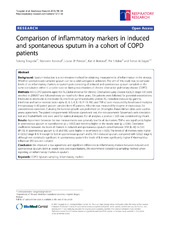Comparison of inflammatory markers in induced and spontaneous sputum in a cohort of COPD patients
Tangedal, Solveig; Aanerud, Marianne; Persson, Louise Jeanette Pauline; Brokstad, Karl Albert; Bakke, Per S.; Eagan, Tomas Mikal
Peer reviewed, Journal article
Published version

Åpne
Permanent lenke
https://hdl.handle.net/1956/10572Utgivelsesdato
2014-11-15Metadata
Vis full innførselSamlinger
Sammendrag
Background: Sputum induction is a non-invasive method for obtaining measurements of inflammation in the airways. Whether spontaneously sampled sputum can be a valid surrogate is unknown. The aim of this study was to compare levels of six inflammatory markers in sputum pairs consisting of induced and spontaneous sputum sampled on the same consultation either in a stable state or during exacerbations of chronic obstructive pulmonary disease (COPD). Methods: 433 COPD patients aged 40¿76, Global initiative for chronic Obstructive Lung Disease (GOLD) stage II-IV were enrolled in 2006/07 and followed every six months for three years. 356 patients were followed for potential exacerbations. Interleukin-6, interleukin-8, interleukin-18, interferon gamma-inducible protein-10, monokine induced by gamma interferon and tumor necrosis factor-alpha (IL-6, IL-8, IL-18, IP-10, MIG and TNF-?) were measured by bead based multiplex immunoassay in 60 paired sputum samples from 45 patients. Albumin was measured by enzyme immunoassay, for concentration correction. Culturing for bacterial growth was performed on 24 samples. Bland-Altman plots were used to assess agreement. The paired non-parametric Wilcoxon signed-rank test, the non-parametric Spearman¿s rank correlation test and Kruskal-Wallis test were used for statistical analyses. For all analyses, a p-value < 0.05 was considered significant. Results: Agreement between the two measurements was generally low for all six markers. TNF-? was significantly higher in spontaneous sputum at exacerbations (p = 0.002) and trending higher at the steady state (p = 0.06). Correlation coefficients between the levels of markers in induced and spontaneous sputum varied between 0.58 (IL-18) to 0.83 (IP-10). In spontaneous sputum IL-18 and MIG were higher in ex-smokers (p < 0.05). The levels of all markers were higher in GOLD stage III & IV except for IL-6 in spontaneous sputum and IL-18 in induced sputum, compared with GOLD stage II, although not statistically significant. In spontaneous sputum the levels of IL-6 were significantly higher if Haemophilus influenzae (HI) was not cultured. Conclusion: We observed a low agreement and significant differences in inflammatory markers between induced and spontaneous sputum, both at steady state and exacerbations. We recommend considering sampling method when reporting on inflammatory markers in sputum.
